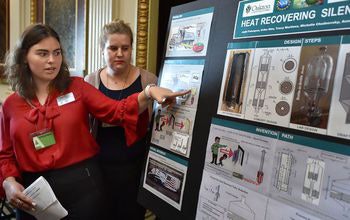Community college students will flex their STEM (science, technology, engineering and mathematics) skills on a national stage with the return of the Community College Innovation Challenge after it was canceled due to COVID-19 last year.
 A student from 2018’s Community College Innovation Challenge pitches his team’s project in Washington, D.C.
A student from 2018’s Community College Innovation Challenge pitches his team’s project in Washington, D.C.Hosted by the National Science Foundation (NSF) and the American Association for Community Colleges (AACC), the annual competition challenges small teams of community college students to develop science-driven solutions to real-world problems.
Last week, the NSF and AACC named 12 teams hailing from community colleges nationwide that will advance to the finals. Among those teams’ projects are proposed solutions to timely issues such as the pandemic, policing behavior and climate change.
The competition “truly showcases the innovation that is happening at the nation’s community colleges,” said Dr. Walter G. Bumphus, president and CEO of AACC. “These students bring to life the next level of cutting-edge thinking and we are proud to partner with NSF to provide this opportunity to students and to advance their initiatives at a national level.”
But there is a twist to the competition. Not only do students have to develop a solution, “they also have to develop a pitch and a business plan to ensure that it’s an actionable program,” said Dr. Martha Parham, AACC’s senior vice president for public relations.
In doing so, entrepreneurs and field experts will train the finalists in June as part of an Innovation Boot Camp, during which finalists will learn how to engage stakeholders and navigate the business side of STEM innovation.
The training leads up to the final Student Innovation Showcase, in which students will present their projects to the public. Later that week, the students will then have the rare opportunity to pitch their projects to Congressional stakeholders and STEM leaders before the NSF and AACC determine the first, second and third-place winning teams. Students typically present on Capitol Hill; however, this year they will present virtually due to the pandemic.
Regardless, for the students — many of whom are from low-income and underrepresented backgrounds — the competition represents their first opportunity to engage in solutions-oriented research. According to the AACC, 29% of community college students are first generation; 20% are students with disabilities; and roughly 50% are Hispanic, Black, Native American or Asian.
“We’re looking at students who perhaps don’t have the same opportunities as those that go to a four-year research university,” said Parham.
Considering those demographics and the fact that 41% of the nation’s undergraduates are enrolled at community colleges, Parham said two-year institutions play a vital role in building a large and diverse STEM workforce.
 A student from 2018’s Community College Innovation Challenge pitches her team’s project in Washington, D.C.
A student from 2018’s Community College Innovation Challenge pitches her team’s project in Washington, D.C.In fact, among U.S. students who earned bachelor’s degrees in science & engineering between 2010 and 2017, about half had done some coursework at a community college and nearly a fifth had earned associate’s degrees
That’s one reason why the NSF has been eager to support community colleges, said Dr. V. Celeste Carter, program director of the NSF’s Division of Undergraduate Education.
“There are so many misperceptions out there amongst the general community about the students that are on community college campuses and what they’re capable of,” said Carter, who hopes the competition’s projects dispel myths about the caliber of work community college students can produce.
One team, for instance, has developed an Officer Aptitude & Stress Information System (or OASIS) that uses artificial intelligence to help police departments better analyze camera footage, GPS systems and heart-rate monitors. Another has created a “sleek, nano-cleanser mask” that has the ability to destroy viruses using nano-fiber weaves with UVC radiation. And another team is developing a filtering mechanism that collects clean water for use in rural areas, homeless populations and in times of emergency — just to name a few of this year’s projects.
“Students have said it’s transformative for them,” said Carter. She explained that, quite often, the competition paves roads to other careers, research or educational opportunities. Additionally, she said some students have even created companies from their prototype products.
This year’s teams represent the twelve following institutions: Austin Community College in Texas; Bergen Community College in New Jersey; Borough of Manhattan Community College in New York; Columbus State Community College in Ohio; Henry Ford College in Michigan; Itawamba Community College in Mississippi; Ivy Tech Community College in Indiana; Johnson County Community College in Kansas; Nashua Community College in New Hampshire; Pasadena City College in California; Tarrant County College in Texas; and Virginia Western Community College in Virginia.
Editor’s Note: This article has been updated for accuracy. Diverse regrets the previous errors.
Jessica Ruf can be reached at [email protected]


















